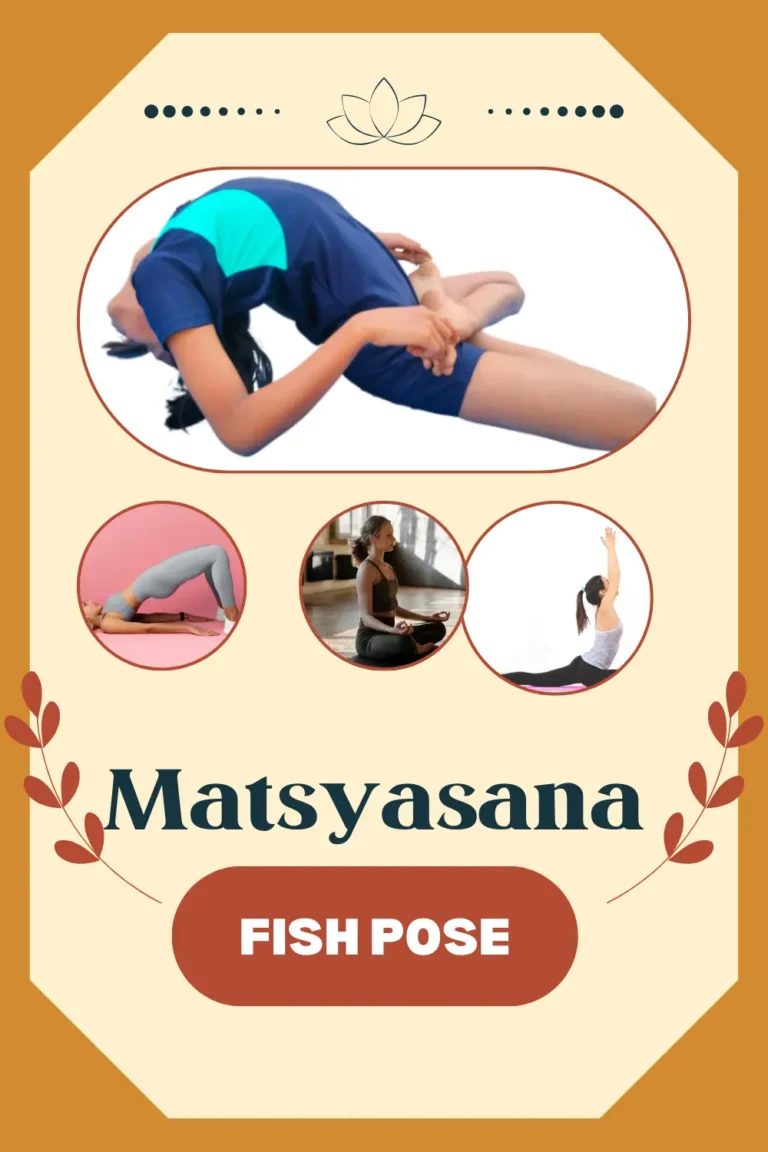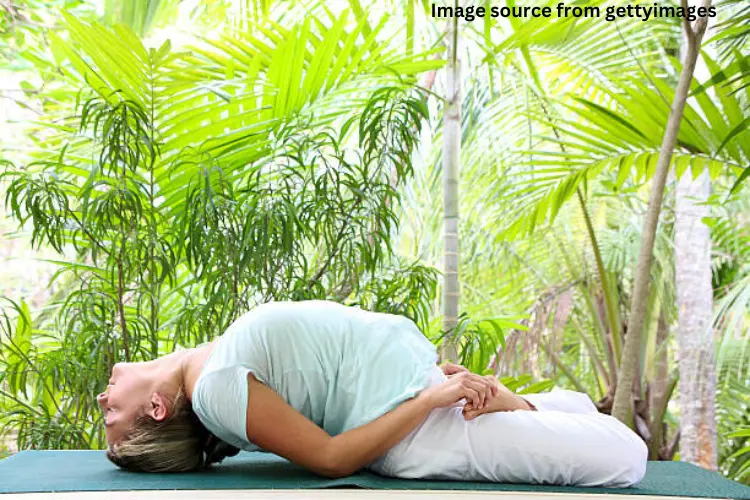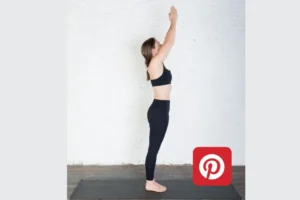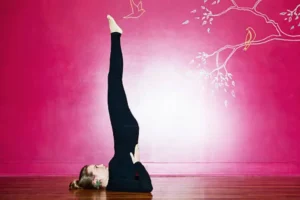Matsyasana, also known as Fish Pose, is a posture. It involves bending forward and backwards. The name “Matsyasana” comes from Sanskrit. “Matsya” means “fish” and
asana” means “pose”.
When we do Matsyasana, we use Plavini Pranayama. With it, we can swim like a fish. That’s why it’s called ‘Matsyasana’. This asana is not very difficult. So, you can easily do this asana with a little practice. So far, this pose has been beneficial for focus. It’s been great for meditation and deep meditation. So, you can do it in three ways.
The first way– lie down facing the ground. Do Padmasana by placing your right foot on the left thigh and your left foot on the right thigh. After this, make a chain by placing both your hands in front of each other and your head on it.
Second way – Now lie flat on the ground and do Padmasana like the first method. Then, hold the toe of the left foot with the right hand and the toe of the right foot with the left hand.
Third way – Lie down facing the ground and do Padmasana as per the first type.
A gentle warm-up before doing Matsyasana
Mountain Pose (Tadasana):
- We have to stand straight and spread our feet hip-width apart.
- Gather our core and lengthen our spine. Then, take a deep breath. This will return your body to a balanced and aligned position.
Uttanasana:
- First, we have to bend our knees to the floor, keeping our thighs parallel. We should rest our palms on our hips and keep our legs straight behind.
- Now inhale slowly and raise your pelvis towards your head. Then, exhale slowly and reach back to put your right hand on your right heel and your left hand on your left heel.
- Now you have to keep your neck long and try to move the sides of your throat straight back. Tilt your head back while maintaining the length of your neck.
Salabhasana:
- First of all, lie down on your stomach with your arms straight out to your sides and rest your forehead on the floor.
- Try to slowly lift your head, chest, arms and legs off the floor and at the same time inhale slowly.
Adho Mukha Svanasana
- The transition from Uttanasana to Downward Facing Dog.
- Press your palms into the mat and lift both of your hips up, trying to form an upside-down V shape with your body.
- Down Dog stretches the spine, hamstrings, and shoulders. It prepares you for backbends like Matsyasana.
Plank Pose
- From Downward Dog, move into Plank Pose.
- Engage your core and keep your body in a straight line and hold for a few breaths.
- Plank strengthens your legs and core, which is very beneficial for Fish Pose.
Breath Consciousness
Steps to Practice Matsyasana (Beginners)
- Step – Start with Shav-Asana by lying straight with your back.
- Step -Keep your buttocks comfortably on the floor.
- Step – Now you have to breathe slowly. Lift your head and shoulders, back, and upper arms off the floor. Arch your back and lift your chest.
- Step – Tilt the head back again. Do it so the body is stable on the top of the head and hips.
- Step – In this position, the shape of the arch in your back will become like a bridge.
- Step – You have to hold the toes of your feet with your hands and in this, you have to bend your neck. This method is most beneficial.
- Step – Start doing this pose for 10 seconds. Then, increase the time as you like.
- Step – While practising the asana, loosen the head with the help of your hands. And after this, leave Padmasana and lie down straight.
How can I modify Matsyasana for beginners?
- When you practice this asana, if you feel tension on your neck then you should use a shaved blanket under your head. This will provide better support to your lower back and neck and then lie down on your back. Lie down gently place your head on the blanket and breathe slowly.
- When we do this asana, it creates tension in our muscles. You can use a blanket roll to reduce the tension in your spine. Place the blanket under your shoulders and perpendicular to your spine. Lie straight on this, which keeps your head in soft contact with the floor.
- While doing this asana, if there is much strain on your waist, then bend your knees. Put your feet on the floor, a width of the mat apart, and keep your toes slightly inside. And let the knees come together. Experiment with different block heights under your head.
- Sitting cross-legged is uncomfortable. You can straighten your legs in front of you and sit on the floor with your legs extended or bent. You can put your hands behind your hips for support. Lift your chest slightly and slowly tilt your head back. Try to keep your neck relaxed.
- If you practice this asana at home then you should take support of the wall. First of all, sit near the wall with your legs folded and lie down with your hips close to the wall. And after this, stretch your arms upward and rest your head on the floor. Your legs can be kept straight or bent. The wall provides slight support to your back and neck, making this asana even easier to perform.
Targeted – Muscles
• Calves
• Quadriceps
• Hamstrings
• Glutes

What are the Benefits of Matsyasana?
Physical Benefits:
- By performing this asana, the body produces adequate digestive juices.
- This asana increases the efficiency of the abdominal cavity.
- Regular practice of this asana helps remove unnecessary fat from our stomach.
- This asana is most useful in providing relief from indigestion and constipation.
- This asana increases the efficiency of the abdominal muscles.
- This asana has a good effect on the facial fibbers and improves our face’s complexion.
- In this position, it is very helpful to keep the windpipe and larynx completely open. Breathe in deeply.
- This pose provides plenty of pure air to the lungs. It also improves lung function.
- It is also very helpful for asthma patients. It cures disorders of the entire respiratory system.
- This asana activates the spine and back muscles.
Spiritual Benefits:
- asana transforms the negative energy inside the person into positive energy.
- This asana also opens Vishuddhi Chakra.
Psychological Benefits:
- It helps to reduce our anxiety.
- It also helps to attempt to produce a high sound or speak.
- The practice of Matsyasana is very important. It brings harmony to our body, mind, and emotions.
What are some common mistakes to avoid in this pose?
Body Alignment
Applying Too Much Weight on the Head
Avoid to overarching of the Lower Back
Head Position
Breathing Techniques
Relaxing Poses After Matsyasana:
Shavasana:
Pavan Muktasana:
Contraindications
- If you have a neck injury then you should not do this asana.
- If you are suffering from Migraine, you cannot perform.
- High or low blood pressure Patients should not do this asana.
- People who have lower back injuries should also avoid this asana.
- During this asana, we should not pull our bodies or put much pressure on our necks. This can cause pain and injury.
- If you have a knee injury, avoid this asana. It pressures your muscles and may increase your pain.








